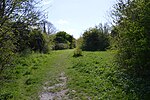Welwyn Garden City
EngvarB from May 2016Former civil parishes in HertfordshireIntentional communities in the United KingdomNew towns in EnglandNew towns started in the 1920s ... and 6 more
New towns started in the 1940sPopulated places established in 1920Towns in HertfordshireUnparished areas in HertfordshireWelwyn Garden CityWelwyn Hatfield

Welwyn Garden City ( WEL-in) is a town in Hertfordshire, England, 20 miles (32 km) north of London. It was the second garden city in England (founded 1920) and one of the first new towns (designated 1948). It is unique in being both a garden city and a new town and exemplifies the physical, social and cultural planning ideals of the periods in which it was built.
Excerpt from the Wikipedia article Welwyn Garden City (License: CC BY-SA 3.0, Authors, Images).Welwyn Garden City
Bessemer Road, Welwyn Hatfield Haldens
Geographical coordinates (GPS) Address Nearby Places Show on map
Geographical coordinates (GPS)
| Latitude | Longitude |
|---|---|
| N 51.8062 ° | E -0.1932 ° |
Address
Bessemer Road
Bessemer Road
AL7 1AH Welwyn Hatfield, Haldens
England, United Kingdom
Open on Google Maps







